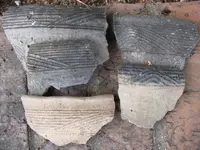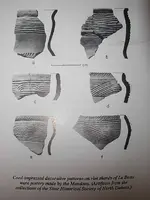Here's a little information about Le Beau ware pottery made by the Mandans. The Hidatsa Indians also made this style of pottery, but they lived further north from your area (north of the Square Buttes).
One of the distinctive technological achievements of the Mandans was their mastery of pottery manufacture. During the period A.D. 1450-1600 Mandan pottery became very sophisticated and highly uniform in construction and appearances. Typical Mandan pottery of this period is known by archaeologists as Le Beau ware. The presence of Le Beau ware can be used to trace the influence of the Mandans during this period. A typical Le Beau ware vessel was a large, globular pot decorated about the upper rim and orifice. The wall of the vessel was especially thin and the paste very compact and well-fired, attesting to the technological excellence of Mandan craftpersons. Mandan vessels typically had a high, smoothly recurved S-shaped rim. The wall of the pot curved gracefully inward at the neck, slightly outward above the neck, and inward again at the vessel mouth. Any vessels other than those with a gentle, high S-rim shape were very rare in Mandan sites of this period. Almost without exception, decoration consisted of a series of parallel lines made by twisted cordage pressed into the face of the rim below the vessel mouth. Typically, many very small diameter cord impressions would be used. The common stylistic motif was a band of parallel, horizontal lines interrupted by curved rainbow patterns, with these patterns centered on nodes or bumps protruding outward from the vessel rim. Some vessels were decorated on the shoulders with patterns of incised lines.
Source: "people of the Willows: The Prehistory and early history of the Hidatsa Indians", by Stanley Ahler. 1991



